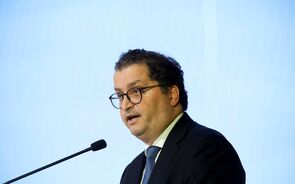13:30 - Dados States
1 Mensagem
|Página 1 de 1
13:30 - Dados States
8:30am 09/02/04 U.S. Q2 PRODUCTIVITY REVISED TO UP 2.5% VS. 2.9%
8:30am 09/02/04 U.S. Q2 NONFINANCIAL PRODUCTIVITY UP 1.4% VS 0.2% Q1
8:30am 09/02/04 U.S. Q2 FACTORY PRODUCTIVITY REVISED TO UP 6.9% VS 7.5%
8:30am 09/02/04 U.S. WEEKLY INITIAL JOBLESS CLAIMS UP 19,000 TO 362,000
8:30am 09/02/04 U.S. 4-WEEK AVG. JOBLESS CLAIMS UP 6,250 TO 343,000
8:30am 09/02/04 U.S. CONTINUING JOBLESS CLAIMS DOWN 5,000 TO 2.882 MLN
ECONOMIC REPORT: Q2 productivity revised down; Nonfarm productivity up 2.5% vs. 2.9% initial estimate
By Gregory Robb, CBS Marketwatch.com Last Update: 8:32 AM ET Sept. 2, 2004
WASHINGTON (CBS.MW) - Productivity in the U.S. nonfarm business sector increased at a 2.5 percent annual rate in the second quarter, revised lower from an earlier estimate of 2.9 percent, the Labor Department estimated Thursday.
The downward revision was slightly larger than expected. Economists polled by CBS.Marketwatch thought non-farm productivity probably expanded 2.7 percent in the revision.
Unit labor costs - a key gauge of inflation and profit pressures - increased at a 1.8 percent annual rate, down from the earlier estimate of 1.9 percent.
Over the past four quarters, the output per hour of American businesses has increased at a 4.6 percent rate, down from a 5.6 percent rate in the first quarter. Unit labor costs fell 0.3 percent over the comparable period.
The revisions show output in the second quarter was lower than initially estimated and hours worked were higher.
Output rose a revised 3.5 percent in the second quarter, down from the initial estimate of a 3.8 percent rise.
Hours worked rose a revised 1.0 percent, up from the initial estimate of a 0.8 percent increase.
In the second quarter, productivity in the nonfinancial sectors increased 1.4 percent on an annualized basis, compared with a 0.2 percent gain in the first quarter.
Unit labor costs in the sector rose 1.6 percent after falling 3.5 percent in the first quarter.
In manufacturing, productivity in the second quarter was revised down to 6.9 percent from 7.5 percent. Unit labor costs fell 3.5 percent, revised from a 2.2 percent decline.
Over the past year, unit labor costs in manufacturing have fallen 2.5 percent, the largest decline since the first quarter of 1995.
In a separate report, the Labor Department said initial weekly jobless claims rose 19,000 to 362,000, the highest level since April, as workers unemployed as a result of Hurricane Charlie seek benefits.
ECONOMIC REPORT: Jobless claims up on hurricane impact
By Gregory Robb, CBS Marketwatch.com Last Update: 8:31 AM ET Sept. 2, 2004
WASHINGTON (CBS.MW) - First-time claims for state unemployment benefits rose sharply in the latest week, in part due to the continued impact of Hurricane Charlie, the Labor Department reported Thursday.
The number of initial claims in the week ending August 28 rose 19,000 to 362,000.
It's the highest level since the week ended April 10.
The consensus forecast of Wall Street economists was for claims to fall to 340,000.
A Labor Department spokesman said a portion of the increase in claims was a result of Hurricane Charlie.
The spokesman said the hurricane accounted for a "little less than half" the increase in the latest week.
Over the past two weeks, claims have spiked up by 29,000 - with about half the increase attributed to the impact of the hurricane, which battered Florida and the Southeast on Aug. 13 and 14.
The more reliable four-week average of initial claims rose 6,250 to 343,000. This is the highest level since the week ended July 31.
Economists put more weight on the four-week average as a guide to the strength of the labor market because it smoothes out one-time distortions, such as weather events.
Meanwhile, the number of Americans receiving state jobless benefits fell 5,000 to 2.882 million in the week ending August 21. This is the lowest level since the week ended July 10.
The four-week moving average of continuing claims fell 4,750 to 2.89 million.
The insured unemployment rate remained at 2.3 percent.
The figures come a day before the Labor Department issues its monthly employment report for August. Economists are expected a report that is neither very strong nor very weak. They are forecasting a modest 158,000 increase in nonfarm payrolls after disappointing gains in June and July.
In a separate report, the Labor Department revised Q2 nonfarm labor productivity lower to an increase of 2.5 percent.
8:30am 09/02/04 U.S. Q2 NONFINANCIAL PRODUCTIVITY UP 1.4% VS 0.2% Q1
8:30am 09/02/04 U.S. Q2 FACTORY PRODUCTIVITY REVISED TO UP 6.9% VS 7.5%
8:30am 09/02/04 U.S. WEEKLY INITIAL JOBLESS CLAIMS UP 19,000 TO 362,000
8:30am 09/02/04 U.S. 4-WEEK AVG. JOBLESS CLAIMS UP 6,250 TO 343,000
8:30am 09/02/04 U.S. CONTINUING JOBLESS CLAIMS DOWN 5,000 TO 2.882 MLN
ECONOMIC REPORT: Q2 productivity revised down; Nonfarm productivity up 2.5% vs. 2.9% initial estimate
By Gregory Robb, CBS Marketwatch.com Last Update: 8:32 AM ET Sept. 2, 2004
WASHINGTON (CBS.MW) - Productivity in the U.S. nonfarm business sector increased at a 2.5 percent annual rate in the second quarter, revised lower from an earlier estimate of 2.9 percent, the Labor Department estimated Thursday.
The downward revision was slightly larger than expected. Economists polled by CBS.Marketwatch thought non-farm productivity probably expanded 2.7 percent in the revision.
Unit labor costs - a key gauge of inflation and profit pressures - increased at a 1.8 percent annual rate, down from the earlier estimate of 1.9 percent.
Over the past four quarters, the output per hour of American businesses has increased at a 4.6 percent rate, down from a 5.6 percent rate in the first quarter. Unit labor costs fell 0.3 percent over the comparable period.
The revisions show output in the second quarter was lower than initially estimated and hours worked were higher.
Output rose a revised 3.5 percent in the second quarter, down from the initial estimate of a 3.8 percent rise.
Hours worked rose a revised 1.0 percent, up from the initial estimate of a 0.8 percent increase.
In the second quarter, productivity in the nonfinancial sectors increased 1.4 percent on an annualized basis, compared with a 0.2 percent gain in the first quarter.
Unit labor costs in the sector rose 1.6 percent after falling 3.5 percent in the first quarter.
In manufacturing, productivity in the second quarter was revised down to 6.9 percent from 7.5 percent. Unit labor costs fell 3.5 percent, revised from a 2.2 percent decline.
Over the past year, unit labor costs in manufacturing have fallen 2.5 percent, the largest decline since the first quarter of 1995.
In a separate report, the Labor Department said initial weekly jobless claims rose 19,000 to 362,000, the highest level since April, as workers unemployed as a result of Hurricane Charlie seek benefits.
ECONOMIC REPORT: Jobless claims up on hurricane impact
By Gregory Robb, CBS Marketwatch.com Last Update: 8:31 AM ET Sept. 2, 2004
WASHINGTON (CBS.MW) - First-time claims for state unemployment benefits rose sharply in the latest week, in part due to the continued impact of Hurricane Charlie, the Labor Department reported Thursday.
The number of initial claims in the week ending August 28 rose 19,000 to 362,000.
It's the highest level since the week ended April 10.
The consensus forecast of Wall Street economists was for claims to fall to 340,000.
A Labor Department spokesman said a portion of the increase in claims was a result of Hurricane Charlie.
The spokesman said the hurricane accounted for a "little less than half" the increase in the latest week.
Over the past two weeks, claims have spiked up by 29,000 - with about half the increase attributed to the impact of the hurricane, which battered Florida and the Southeast on Aug. 13 and 14.
The more reliable four-week average of initial claims rose 6,250 to 343,000. This is the highest level since the week ended July 31.
Economists put more weight on the four-week average as a guide to the strength of the labor market because it smoothes out one-time distortions, such as weather events.
Meanwhile, the number of Americans receiving state jobless benefits fell 5,000 to 2.882 million in the week ending August 21. This is the lowest level since the week ended July 10.
The four-week moving average of continuing claims fell 4,750 to 2.89 million.
The insured unemployment rate remained at 2.3 percent.
The figures come a day before the Labor Department issues its monthly employment report for August. Economists are expected a report that is neither very strong nor very weak. They are forecasting a modest 158,000 increase in nonfarm payrolls after disappointing gains in June and July.
In a separate report, the Labor Department revised Q2 nonfarm labor productivity lower to an increase of 2.5 percent.
-
Info.
1 Mensagem
|Página 1 de 1
Quem está ligado:


